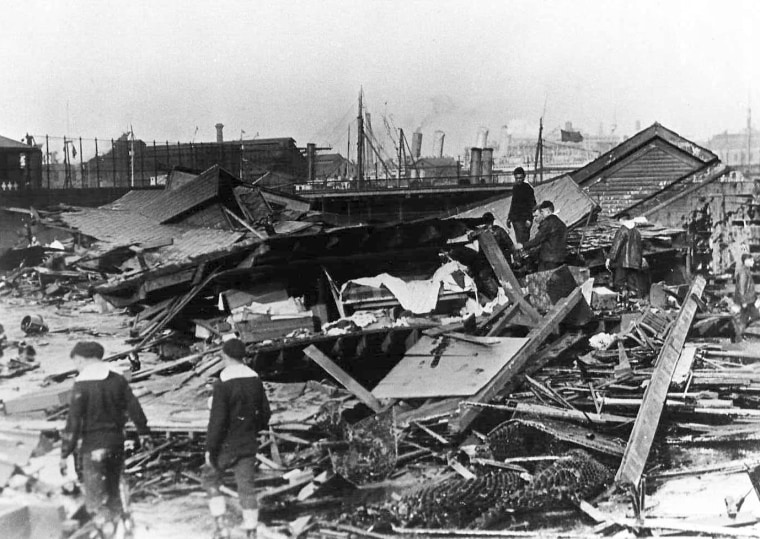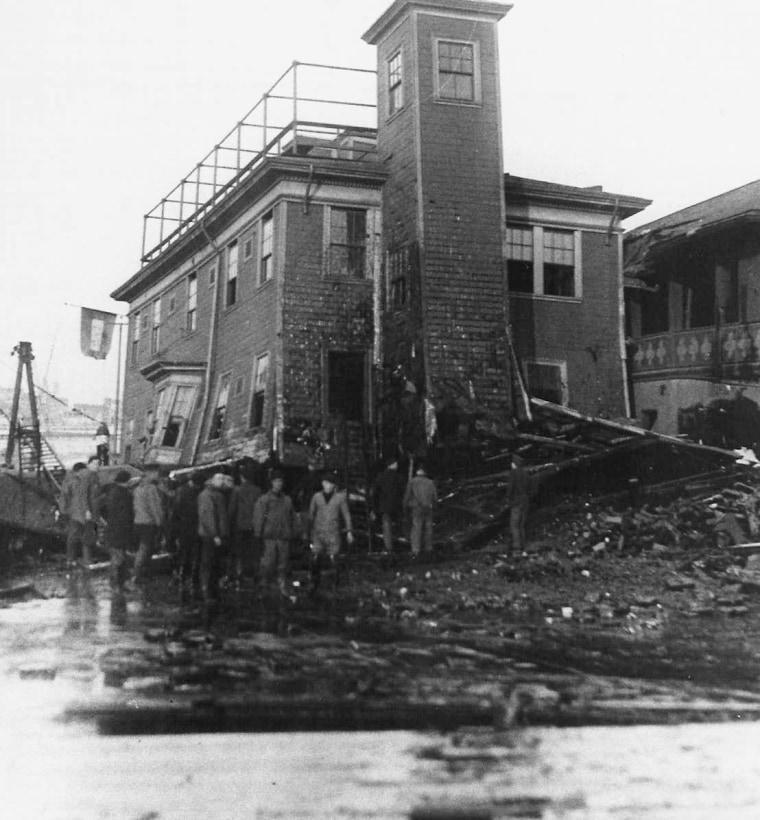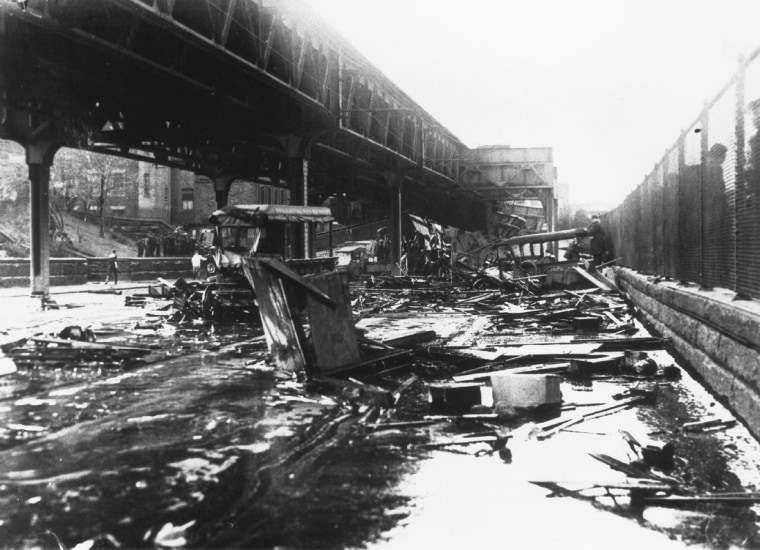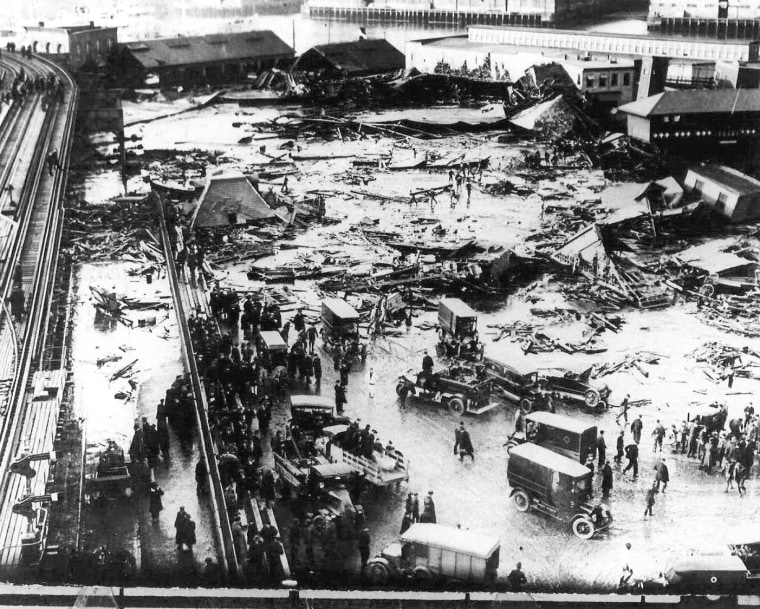On Jan. 15, 1919, at around 12:30 p.m., Boston Police patrolman Frank McManus was at a call box reporting back to headquarters when he heard a loud scraping and grinding noise. Pausing to figure out the source, he suddenly found himself overcome with shock.
McManus managed to make out to the dispatcher: “Send all available rescue vehicles and personnel immediately — there’s a wave of molasses coming down Commercial Street," according to Stephen Puleo, historian and author of “Dark Tide: The Great Boston Molasses Flood of 1919.”
The wave was 2.3 million gallons, moving at 35 miles per hour, 25 feet high and 160 feet wide at its outset, rushing through the city's crowded and densely populated North End.
A massive, 50-foot-high steel tank holding the molasses had ruptured. People in its direct path were immediately swallowed, drowned and asphyxiated by the notoriously viscous substance.
Within seconds, two city blocks were flooded. Puleo told NBC News that the tide of molasses ripped the Engine 31 Firehouse from its foundation, almost sweeping the building into the Boston Harbor. The brown wave busted windows, overturned railcars and flooded homes. By sunset, 21 people were dead, 150 were injured and the North End looked like it had been bombed.

THE STICKY TSUNAMI
If you're familiar with the phrase “slow as molasses,” it’s hard to make sense of the 1919 flood. Dr. Nicole Sharp, a science communicator and an expert in fluid dynamics, said that when she heard the 35-mph number, she was surprised. “One of my first questions was, is that number plausible?” she said.
Sharp decided to look into the science behind the flood, along with a team of scientists at Harvard. “I found that the initial wave could have moved at that speed,” she said.
Sharp said the flood could be broken down into two stages, with the first called “The Tsunami.”
“Molasses is 1.5 times heavier than water. It’s very dense,” Sharp said. The tank, piled so high with molasses, stored a large amount of potential energy. When the tank ruptured, all that potential energy became kinetic energy. “The fact that the molasses is extremely viscous doesn't matter for the first 60-90 seconds. The inertia is so much more powerful than the forces that can be moved by the viscosity.”
When the tank broke and the molasses exploded, there was no outrunning it. “When the initial wave came through, it just pulverized everything,” Sharp said. People’s bones were crushed, their bodies thrown onto buildings and train cars. Many survivors had broken backs and fractured skulls.
During the second stage of the flood, “the inertia runs out as the molasses spreads — that’s when viscosity starts to matter," Sharp said, referring to a liquid's resistance to flow. As molasses flooded the streets, it slowed but became thicker and stickier, and still difficult to escape. People were trapped, with witnesses described trying to breathe while stuck, gasping for their lives and simultaneously trying to avoid inhaling too much.
Cold weather made things worse. “As the temperature dropped, the molasses got harder and harder to move, which is a problem when you’re trying to shift rubble," Sharp said.
It was also a problem for rescuers who were trying to lift people out of the molasses. Firefighters had to spread ladders over it to prevent themselves from falling into sticky vats that were once streets.

HOW DID THIS HAPPEN?
A U.S. Industrial Alcohol (USIA) subsidiary, Purity Distilling Co., built the tank in 1915 to keep up with increasing demand for military weapons. The tank stored molasses from Cuba, Puerto Rico and the West Indies, which was then brought to a distillery in East Cambridge and turned into industrial alcohol. Companies in the U.S., England, and France bought the alcohol, which they desperately needed to make dynamite, smokeless powder and other explosives used in World War I.
Puleo explains in his book that the project was rushed from the beginning. He told NBC News that the manager of the project, Arthur Jell, USIA’s treasurer, had “no technical experience, no architectural experience, no engineering experience.”
From the beginning, Jell sidestepped safety precautions. Instead of filling the entire tank with water after it was finished to test for leaks, he only put in six inches of water. “The tank starts leaking on Day 1,” Puleo said.
Ronald Mayville, a senior principal at the engineering firm Simpson Gumpertz & Heger in Massachusetts, has studied the molasses flood in his spare time. Mayville analyzed the flood using today’s engineering tools and suspects the tank might have been designed for water instead of molasses. “The stress in the tank is directly linked to the fluid inside,” he said. “It should have been very straightforward." Building the tank, Mayville explained, is "a relatively simple calculation that most engineers could do in that day.”
Even though workers alerted USIA to the leaks, the company remained unperturbed. Profits from the war were pouring in as steadily as molasses was leaking out of the tank. In 1918, in an effort to shield the leaks and avoid costly fixes, Jell even had the steel-colored tank painted brown, to camouflage the oozing molasses.
Puleo said that seven days before the flood, on a day with a low of 2 degrees Fahrenheit, a new shipment dumped more than half a million gallons of molasses into the poorly built tank.
As warm molasses from the ship mixed with cold molasses in the tank, it triggered a fermentation process that produced gas. People reported hearing the tank whining and groaning. A week later, with the almost-full tank weighing 26 million pounds and the gas inside putting extra pressure on the steel walls, it ruptured.

THE FLOOD’S LEGACY
Though the flood has been long forgotten in popular memory, its legacy remains. Puleo told NBC News that “the tank didn’t even require a permit because it was considered a receptacle, not a building," adding, "Every building construction standard that we sort of take for granted today comes about because of the Molasses Flood.”
In his book, Puleo writes, “Shortly after the flood, the Boston Building Department began requiring that all calculations of engineers and architects be filed with their plans and that stamped drawings be signed.” This later became standard practice across the country.
Sharp has a more abstract take. She hopes the flood taught “people to have some respect for the destructive power of things we usually think of as harmless.”
USIA did not rebuild the tank, and new war technology made the mass distillation of molasses for industrial alcohol obsolete. Much of the area flooded by molasses is now in Langone Park, where a small plaque hangs to commemorate the tragedy.

